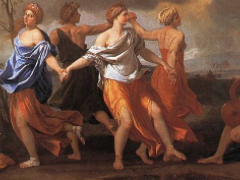
From the Editor's Note:
When it comes to the dynamic arts - theatre, dance and music - time becomes one of the most important factors. All three take place within the framework of time, and time marks their boundaries. Having said this, one must stress the fact that, within these dynamic arts, there is one such art that relies completely on time, and this is music. Moreover, time is the only concrete element in music...
Music, in which case, superimposes “sounding time” upon “passing time” and, by way of this, gives music its unique impact. Thus music enables us to break free from any intermediary factor like canvas, stone, color or figures that might appear in a novel or on stage, these, by their very nature, forming a buffer between us and the artistic creation...
This is why the new editorial board of our publication “Music and Dance in Time” has seen fit to dedicate this first issue, published after a hiatus of some years, to the most intriguing subject of “time”.
Music And Dance In Time - Read the publication here »
In this Issue:
Composer Professor Tzvi Avni wrestles with the problem of time at large and dwells on the concept of time in the movement of science and music, examining the time concept from its historical development in western- and non-European music.
Dr. Alon Shab’s article deals with Henry Purcell’s theatre music and explores the time relationships between theatre performance and Purcell’s incidental music, while pianist Dr. Ron Regev has written an analytical study of tempo regularity of Mendelssohn’s piano trio and sketches the changes that occurred at the time of composition.
Roy Oppenheim examines our attitude to time by asking how one can characterize the space between two notes; he sheds new light on the term: “duration”.
Dr. Amit Weiner devotes his article to the time component in compositions of Arvo Pärt and examines the concept of time and space in Pärt’s music.
Double bass player Dr. Michael Klinghoffer actually builds his article in sonata form and examines time in relationship to form as well as the difference between musical- and physical time, while flautist Professor Michael Melzer, also approaching the subject from a formal
point of view, focuses on the form of the “canon”, (including all canonical forms, such as the rondo, passacaglia, etc.) Melzer also examines the canon in its non-musical meaning, as seen through the eyes of the performer.
Composer and researcher Dr. Stephen Horenstein embarks on a personal journey into the realm of time dilation through the prism of his own composition, and Dr. Yair Ehrlich examines time regularity and irregularity in the phrase structure of Domenico Scarlatti’s keyboard sonatas.
Two articles are devoted to the concept of time in dance: Dr. Vered Aviv investigates the difference of time prediction in music and dance, and choreographer Amir Kolben probes different aspects of dance time by disassembling a complete movement, this also including form, direction and energy and the focusing on time itself.

